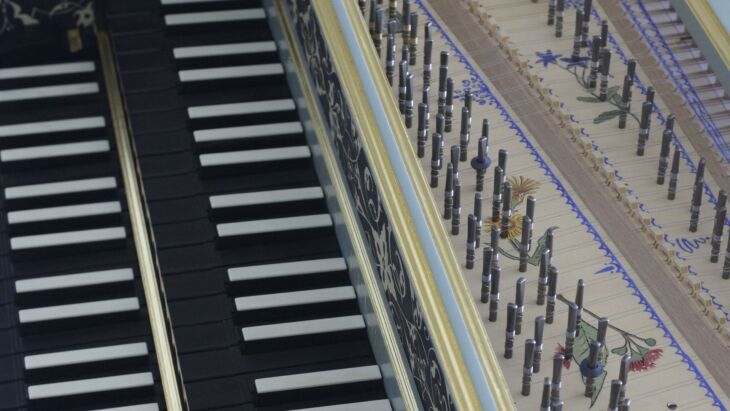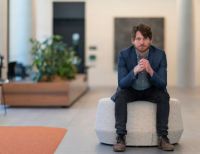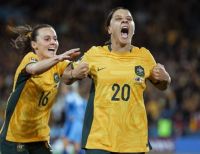Tucked away in a corner on the fifth floor of the ANU School of Music, a small rosewood table is hidden under a soft red blanket. Pulling back the blanket, Dr Scott Davie lifts up its decorated top to reveal a sewing table.
There's a pin cushion in the middle and 19 little boxes around the outside -- presumably where one would keep needles, thread and other implements. But not all is as it seems. Davie pulls the ivory handles to gently remove a row of boxes at the edge and exposes the table's secret: a four-octave keyboard.
The Viennese Sewing Table Piano was crafted in 1846 and is one of several surprising and special instruments in the ANU Keyboard Institute -- a collection of about 30 keyboards, harpsichords and pianos.
"It's absolutely beautiful and it's incredibly valuable as well," Davie says, admiring the sewing table piano. "You can see the keys are tiny; it's a very small keyboard.
"There's only one copy exactly like this that we know of, which is in the Smithsonian in America."
Why someone would hide a keyboard within the sewing table is a mystery.
"I don't know whether it's the idea of a closet musician, or whether it was just a beautiful curiosity that they knew that they could make," Davie says.
Centuries of history
The Keyboard Institute was established in 2005 by Dr Geoffrey Lancaster and is thought to be the largest accessible and playable collection in the southern hemisphere. It includes authentically old instruments and modern copies of old instruments, charting trends and developments over more than 200 years.
"Musical instruments at that time were like the computers of today in terms of the technology that went into them, and you can see the technological developments of these instruments as they went on," Davie, who now oversees the collection, says.
"It was a real thing in the industry to see how clever you could be and what sort of things you could actually do to create a musical instrument.
"This is the time when if you wanted music, you actually had to have a musical instrument or a musician; there was no such thing as radio or anything like that. So, musical instruments had a much more special value as being the only thing that would make music.
"They're more than pieces of furniture."
The oldest piece in the collection is a Henri Henrion square piano. Timeworn and marked in some places, the Henrion is believed to have been crafted about 1770. It was donated to the University in 2009 by Dr Andrew Nolan, who found the instrument on eBay.
"It's had a bit of restoration, but not much," Davie says.
The soundboard is new, as are the strings. "But, as you can see, all the wood is 252 years old, and wood bends and felt deteriorates. You could recondition this instrument so that everything's like new, but then it's not really authentic."
In 2020 Davie co-led a project to collaborate with Indigenous composers and four musicians from the Ngarra Burria First Nations Composers Initiative were invited to write music especially for the Henrion. The project coincided with the 250th anniversary of Captain James Cook's landing in Australia and the keyboard was chosen for its age.
"It was built in 1770 and it still sings," Davie says. "There are lots of noises and things like that, but there's still a musical voice inside of it which is really lovely.
"Older instruments are always going to be sort of problematic to a certain extent, but they are very, very interesting and there's a lot we can learn from them."
More than a museum
But having well-crafted modern copies is important too. They provide an opportunity for students to play music on the instruments for which it was written and have it sound like the composers intended. Davie, the Deputy Head of the ANU School of Music and a lecturer in piano, says students are encouraged to practise on the collection.
"All of our students can come in here and play these instruments and get insight into how they would have sounded, how they would have felt and other little quirks you discover after you play them for a while," he says.
"If you have a modern copy where the person who's built it has really studied the model, you can recreate an instrument of the period which is going to work really, really well."
There are several historical replicas in the collection, including a powder blue double harpsichord, based on those made by the Ruckers family based in Antwerp from the 17th century. Built in 2020 by Carey Beebe, it's one of the most recent acquisitions. The soundboard, visible when the harpsichord's top is lifted, is decorated with hand painted Australian native flowers and plants, including banksia, Sturt's desert pea, wattle and the ACT floral emblem, Wahlenbergia gloriosa.
"Most students will play music by Bach or Mozart or Beethoven or Schubert; these are the sorts of instruments those composers played," Davie says, pointing to three modern copies of keyboards from the 18th and 19th centuries -- replicas of a 1788 fortepiano by Johann Andreas Stein, a Viennese fortepiano from 1796, and a 1819 fortepiano by Conrad Graf.
"I love these three instruments. I'm not an early music specialist, but just running my fingers over them, it's extraordinary to sort of get an idea of how they sound."
Playing pieces from such composers on more recent instruments, modern pianists can encounter some puzzling patterns that don't seem to make sense.
"Then you come in here and in five minutes of playing one of these instruments you realise they work in a completely different way," Davie says. "You don't need to use as much strength to play these notes and it sounds completely different.
"If you're a big fan of a very, very full sound, sometimes the resonances when you play chords can sound quite muddy. But you can play one of these instruments and it's like, 'ah, okay, now that makes sense'."
Then there is the keyboard that doesn't make any sound at all. And it's not meant to. The 1920 practice keyboard is silent, and as the name suggests, it's for practising.
It's probably not ideal for beginners, Davie admits, but it's useful for trained pianists and often more portable than other keyboards.
"Rachmaninoff, for example, when he wrote his third piano concerto, he only finished the part just before he sailed to America, which is where it had its first performance," he says.
"So, he took one of these instruments and practised the part on what we call a 'dummy keyboard' on the boat as he was sailing across to America."
Preserving the past
Work to maintain and restore the pieces in the collection is ongoing. One of the next projects is an 1802 square piano built by John Broadwood. It was found in the school's basement, where other neglected and broken instruments were languishing. The piano hasn't been restored before, which presents an exciting opportunity for the school.
"Quite often with these instruments, maybe 150 years ago somebody tried to restore it so it's not really authentic. But conservation methods today are much better than they were even 50 years ago," Davie says.
"When this instrument is restored it will probably be our best square piano."
Piano Week at the ANU School of Music
A selection of period and replica instruments from the collection will be showcased in an upcoming concert during Piano Week, hosted by the ANU School of Music from 8-11 August. Four concerts will feature local and international pianists and students. Register for the events at the links below.
Monday 8 August, 7pm: The Herscovitch Piano Duo (Sydney) will perform works for two pianos by Australian composers Roger Smalley and Kate Moore, as well as Igor Stravinsky and Benjamin Britten.
Tuesday 9 August, 7pm: The Neeman Piano Duo will present a program featuring original arrangements for piano duet by American composers William Bolcom and Samuel Barber, as well as favourites by Bach, Tchaikovsky, and Scriabin.
Wednesday 10 August, 7pm: The Friends Historical Instruments Showcase Concert will include performances from harpsichordist Ariana Odermatt, fortepianist Marie Searles, baroque violinist and viola d'amore player John Ma, Dr Scott Davie, Lecturer in Classical Piano, Performance Convenor, and Deputy Head of the School of Music, and some of the school's finest keyboard students. This concert will feature pieces from the ANU Keyboard Institute.
Thursday 11 August, 7pm: Roy Howat, Keyboard Research Fellow at the Royal Academy of Music, London, and a Senior Research Fellow at the Royal Conservatoire of Scotland, Glasgow, will perform works by Chopin, Borodin, Chabrier, Fauré, Elgar, Debussy and Ravel.
















